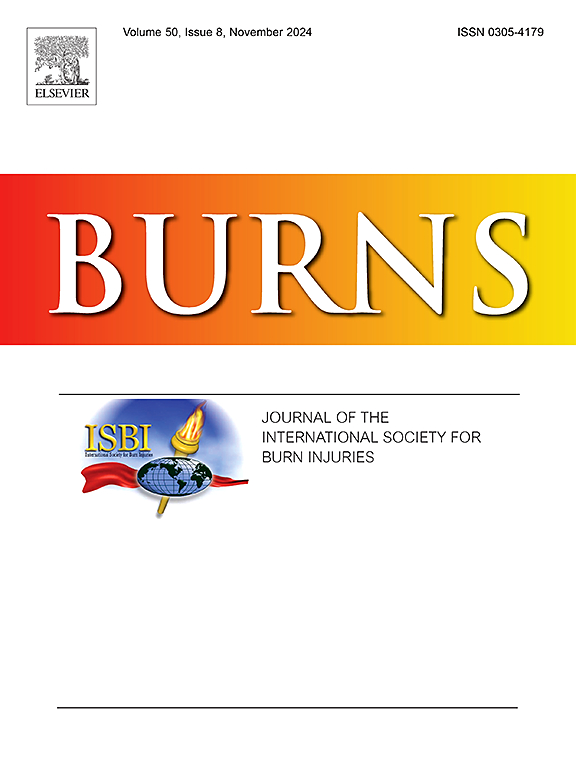Identification of lncRNA biomarkers for keloid diagnosis and functional characterization of CPEB2-AS1
IF 3.2
3区 医学
Q2 CRITICAL CARE MEDICINE
引用次数: 0
Abstract
Background
Keloids are pathological scars marked by excessive tissue growth, and their diagnosis currently depends on clinical observation, lacking objective biomarkers. Although the regulatory role of long non-coding RNAs (lncRNAs) in various diseases has drawn attention, their function in keloids remains unclear.
Methods
This study employed high-throughput sequencing, bioinformatics analysis and machine learning algorithms to identify differentially expressed lncRNAs in keloid tissues and to construct a diagnostic model. The relationship between these lncRNAs and immune responses, as well as gene expression regulation, was explored through immune signature analysis and co-expression networks. The role of CPEB2-AS1 in keloids was investigated through expression validation, pan-cancer analysis and functional experiments.
Results
Four key differentially expressed lncRNAs were identified, enabling the development of an effective diagnostic model that distinguishes keloid tissues from healthy controls. Immune signature analysis revealed a positive correlation between CPEB2-AS1 and immune cell activity. Co-expression networks and functional enrichment analysis suggested that these lncRNAs may regulate RNA processing and nucleic acid binding. Expression validation and pan-cancer analysis confirmed their abnormal expression in keloids. Functional experiments demonstrated that CPEB2-AS1 significantly influences cell proliferation, migration, invasion and apoptosis.
Conclusion
This study identifies new molecular markers for the early diagnosis of keloids and highlights the potential role of CPEB2-AS1 in keloid progression, offering insights for future therapeutic strategies.
用于瘢痕疙瘩诊断和CPEB2-AS1功能表征的lncRNA生物标志物鉴定
瘢痕疙瘩是一种以组织过度生长为特征的病理性疤痕,目前其诊断依赖于临床观察,缺乏客观的生物标志物。尽管长链非编码rna (lncRNAs)在各种疾病中的调节作用已引起人们的关注,但它们在瘢痕疙瘩中的功能尚不清楚。方法采用高通量测序、生物信息学分析和机器学习算法,鉴定瘢痕疙瘩组织中差异表达的lncrna,并构建诊断模型。通过免疫特征分析和共表达网络,探索这些lncrna与免疫应答以及基因表达调控的关系。通过表达验证、泛癌分析和功能实验探讨CPEB2-AS1在瘢痕疙瘩中的作用。结果鉴定了四个关键的差异表达lncrna,从而建立了一种有效的诊断模型,将瘢痕疙瘩组织与健康对照区分开来。免疫特征分析显示CPEB2-AS1与免疫细胞活性呈正相关。共表达网络和功能富集分析表明,这些lncRNAs可能调节RNA加工和核酸结合。表达验证和泛癌分析证实其在瘢痕疙瘩中的异常表达。功能实验表明,CPEB2-AS1显著影响细胞的增殖、迁移、侵袭和凋亡。结论本研究确定了瘢痕疙瘩早期诊断的新分子标记,并强调了CPEB2-AS1在瘢痕疙瘩进展中的潜在作用,为未来的治疗策略提供了见解。
本文章由计算机程序翻译,如有差异,请以英文原文为准。
求助全文
约1分钟内获得全文
求助全文
来源期刊

Burns
医学-皮肤病学
CiteScore
4.50
自引率
18.50%
发文量
304
审稿时长
72 days
期刊介绍:
Burns aims to foster the exchange of information among all engaged in preventing and treating the effects of burns. The journal focuses on clinical, scientific and social aspects of these injuries and covers the prevention of the injury, the epidemiology of such injuries and all aspects of treatment including development of new techniques and technologies and verification of existing ones. Regular features include clinical and scientific papers, state of the art reviews and descriptions of burn-care in practice.
Topics covered by Burns include: the effects of smoke on man and animals, their tissues and cells; the responses to and treatment of patients and animals with chemical injuries to the skin; the biological and clinical effects of cold injuries; surgical techniques which are, or may be relevant to the treatment of burned patients during the acute or reconstructive phase following injury; well controlled laboratory studies of the effectiveness of anti-microbial agents on infection and new materials on scarring and healing; inflammatory responses to injury, effectiveness of related agents and other compounds used to modify the physiological and cellular responses to the injury; experimental studies of burns and the outcome of burn wound healing; regenerative medicine concerning the skin.
 求助内容:
求助内容: 应助结果提醒方式:
应助结果提醒方式:


